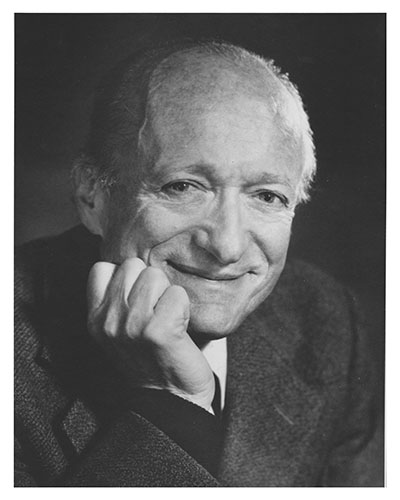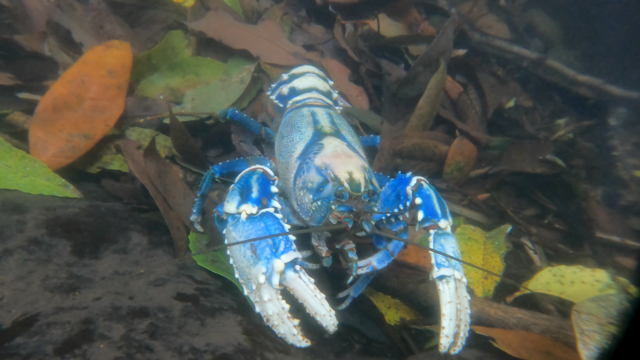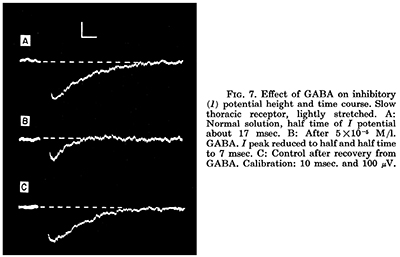CV
Early Years »
Scientific Career »
Family »
Research Contributions »
Early studies on synaptic transmission »
Amphibian skeletal muscle fibres and muscle spindles »
Function of retinal ganglion cells »
Neural excitation and inhibition of stretch receptors in muscles of the crayfish »
Proving GABA as an inhibitory neurotransmitter »
Experimental evidence for presynaptic inhibition »
Role of glia »
Later studies on synaptic transmission »
Early Years
Stephen William Kuffler was born on August 24th 1913 in Táp, in Austria-Hungary. Following the early death of his mother he was raised and educated first at home, then from the age of 10 in a Jesuit boarding school in Austria. In 1932 he went to the Medical School in Vienna and obtained his M.D. five years later. After a short clinical practice in Vienna – fleeing from the German occupation in 1938 – he moved to England for a few months and then emigrated to Australia.
One of the group leaders at the Sydney Hospital Kanematsu Memorial Institute of Pathology – John Carew Eccles, who later became a Nobel Laureate in physiology or medicine –provided a job for him. There he met his lifelong friend and colleague, Bernard Katz. Bernard Katz won the Nobel Prize in physiology or medicine in 1970. After the war, the cultural administration failed to recognize the historical situation and – seeking better opportunities – they left Australia forever. Eccles went to the University of Otago in New Zealand. Katz went to join A.V. Hill at University College London where he later became a professor with his own research group.
Scientific Career
After a short stay in the University of Chicago, Kuffler moved to the Wilmer Institute of Ophthalmology at The Johns Hopkins Hospital in Baltimore. Here he formed his team with young scientists David H. Hubel, Torsten N. Wiesel, Edwin Furspan, David Potter and the engineer and chief technician Robert B. Bosler. Soon after, at the invitation of Otto Krayer, professor at the Department of Pharmacology, Harvard Medical School the team moved to Cambridge, Massachusetts, where they were joined by the biochemist Edward Kravitz. Within one team – first in the history of neuroscience – they applied physiological, biochemical, anatomical and histological techniques to the exploration of the nervous system. Kuffler spent the summers with members of the lab in the Marine Biological Laboratory at Woods Hole, except from 1967 to 1971, when they worked in the Salk Institute for Biological Studies in La Jolla. He acquired US citizenship in 1953.
He had an uncanny ability to find the right species for solving or clarifying any problem. He ranged over vertebrates and invertebrates, would find just the right relationships, help to solve a problem and then hand the preparation to one or another of his younger colleagues. While he provided a stimulating intellectual environment and great inspiration for his colleagues, he also co-authored papers to which he contributed with his own experimental work. He also influenced Eric Kandel (Nobel Laureate in physiology or medicine, 2000) and many others in their choice of research field. Kuffler’s unique style and precision of his reviewing of papers was highly appreciated.
Family
Stephen (Steve) W. Kuffler married Phyllis Shewcroft in 1943. She obtained her M.D. from Harvard. They raised four children; Suzanne, Damien, Eugenie and Julian. Steve’s wider scientific family often enjoyed the family’s hospitality. In spite of his failing health Kuffler passionately continued with his research, travel and sport. Shortly before his death, his desire to visit his native Hungary was fulfilled when he participated in the International Physiological Congress in Budapest in 1980. On the same hectic tour, he received an Honorary Doctorate at Oxford, gave the Heisenberg Lecture in Munich and lectured at Vienna and Paris. After one of his regular long swims in the sea at Woods Hole, he died of a heart attack on the 11th October1980.
Research Contributions
More than ninety papers under Kuffler’s name demonstrate his exceptionally wide interests. In each subject he focussed on a poorly understood detail, which he brilliantly illuminated and explained with decisive experiments. The clarity and reasoning of his texts rarely needed lengthy discussion.
J. G. Nicholls – one of his younger colleagues – collected his papers in eight groups, as follow (pdf):
Early Studies on Synaptic Transmission
He used in vitro preparations in which a single muscle fibre with its afferent nerve fibre was isolated. Papers published in Australia opened the way to further seminal studies on the end plate potentials, as well as the effects of calcium and denervation on neurotransmission.
Eccles J. C., Katz B. and Kuffler S. W., Nature of the 'endplate potential' in curarized muscle. J. Neurophysiol. 4:362-387, 1941.
Works with Bernard Katz on crustacean muscle-nerve isolates paved the way to explanation of synaptic transmission.
Katz B., Kuffler S. W., Excitation of the nerve-muscle system in Crustacea. Proc R Soc Lond B Biol Sci. 133:374-389, 1946.
Kuffler S. W., Katz B., Inhibition at the nerve muscle junction in crustacea. J Neurophysiol. 9:337-346, 1946.
Amphibian skeletal muscle fibres and muscle spindles
The first papers published in America were on the slowly contracting muscle fibres of the frog.
Kuffler S.W., A second motor nerve system to frog skeletal muscle. Proc Soc Exp Biol Med., 63(1):21-23, 1946.
Kuffler S. W., Laporte Y., Rans Meier R. E., Reflex activity of the frog's small-nerve motor system Fed Proc. 6(1 Pt 2):146, 1947.
These early discoveries triggered later works in the Wilmer Institute with Peter Quilliam and Cuy Hunt on the neural control of mammalian muscle fibres. The experimental layout was simple and elegant. While the afferent fibres were stimulated they monitored the activity of the sensory nerve from a single muscle spindle. Stimulation of thick fibres – as it was expected – elicited muscle contraction. When thin motor fibres were stimulated they observed no contraction, but the discharge frequency in sensory fibres was significantly enhanced. They explained this phenomenon with the function of specialized thin muscle fibres in the muscle spindles.
Kuffler S. W., Hunt C. C., Quilliam J. P., Function of medullated small-nerve fibers in mammalian ventral roots; efferent muscle spindle innervation. J. Neurophysiol. 14(1):29-54, 1951.
Back to the top of the page »
Function of retinal ganglion cells
In a series of landmark publications commencing from 1952 from the Wilmer Institute, Kuffler laid the foundation of modern visual neurophysiology. Instead of diffuse illumination, he used small, distinct and carefully positioned patterns of light to stimulate retinal ganglion cells simultaneously monitoring their activity. For this purpose, with S. A. Talbot he invented a special purpose ophtalmoscope.
Talbot S. A., Kuffler S. W., A multibeam ophthalmoscope for the study of retinal physiology. J Opt Soc Am. 42(12):931-936, 1952.
In a whole series of single-author landmark papers, he reported the receptive fields of ganglion cells, demonstrating that they were circular and had two concentric and antagonistic parts. He found two kinds of cells, which differed in the activation or inhibition by centrally applied illumination. He named the former ON-center and the latter Off-center cell. He explained this dichotomy on the basis of the effects of excitatory and inhibitory neural inputs to the ganglion cells.
Kuffler S.W., Neurons in the retina; organization, inhibition and excitation problems. Cold Spring Harb Symp Quant Biol. 17:281-292, 1952
Kuffler S. W., Discharge patterns and functional organization of mammalian retina. J Neurophysiol. 16(1):37-68, 1953
These papers provided the basis for further discoveries by David Hubel and Torsten Wiesel in the mammalian central visual pathways, which were recognized with Nobel Prize in physiology or medicine in 1981.
Kuffler SW., The single-cell approach in the visual system and the study of receptive fields. Invest Ophthalmol. 12(11):794-813, 1973
Neural excitation and inhibition of stretch receptors in muscles of the crayfish
With Carlos Eyzaguirre, Kuffler carried out pioneering experiments on mechano-receptors in crustacean muscles. They characterized the generator potentials and action potentials.
Eyzaguirre C. Kuffler S. W. Processes of excitation in the dendrites and in the soma of single isolated sensory nerve cells of the lobster and crayfish. J. Gen. Physiol. 39(1):87-119, 1955
These results led to further electrophysiological and pharmacological experiments with Charles Edwards, which led to the recognition of the role of GABA (gamma-aminobutyric acid) in neural inhibition.
Kuffler S. W., Edwards C., Mechanism of gamma aminobutyric acid (GABA) action and its relation to synaptic inhibition. J Neurophysiol. 21(6):589-610, 1958
Proving GABA as an inhibitory neurotransmitter
Working in the Neurophysiology Laboratory of the Department of Pharmacology at Harvard Medical School – in collaboration with Edward Kravitz, David Potter and others – he proved that the effect of GABA is identical with the natural, endogenous inhibitory compound in Crustacea. Parallel chemical analysis showed that inhibitory nerves contained a thousand times more GABA than the excitatory ones. The results opened the way to further studies on mammalian brains and to the final conclusion that GABA is one of the main inhibitory neurotransmitter in the nervous system.
Dudel J., Gryder R., Kaji A., Kuffler S. W. and Potter D. D., Gamma-aminobutyric acid and other blocking compounds in Crustacea. I. Central nervous system. J Neurophysiol. 26:721-728, 1963.
Kravitz E. A., Kuffler S. W., Potter D. D. and Vangelder N. M., Gamma-aminobutyric acid and other blocking compounds in Crustacea. II. Peripheral nervous system. J Neurophysiol. 26:729-738, 1963
Kravitz E. A., Kuffler S. W. and Potter D. D., Gamma-aminobutyric acid and other blocking compounds in Crustacea. III. Their relative concentrations in separated motor and inhibitory axons. J. Neurophysiol. 26:739-751, 1963.
Experimental evidence for presynaptic inhibition
Working at Harvard with Josef Dudel, prior to the discoveries above, he Kuffler recognized that stimulation of inhibitory nerves had a twofold effect. In addition to weakening the muscle contraction, it decreased the transmitter release from excitatory nerve terminals. They suggested a plausible scheme for presynaptic inhibition, an area that is still under investigation today.
Dudel J., Kuffler S. W., Presynaptic inhibition at the crayfish neuromuscular junction. J. Physiol. 155:543-562, 1961
Role of glia
In the middle of the last century glia was regarded as mere support to nerve cells. Characteristic of his research attitude, he started working on glia with David Potter. They showed that, in the neural ganglia of the leech, glial cells have lower (-60 to -75 mV) resting membrane potential than neurons (-40 to -50 mV), were electrically coupled and did not produce action potentials. Later, with John Nicholls, he proved that small molecules and electrolytes from the blood pass through extracellular clefts rather than glial processes. Furthermore, in collaboration with Dick Orkland, he demonstrated that in amphibians interstitial potassium concentration increases and glia become depolarized following nerve activity. These results provided important clues for our understanding of glial function in the balance and chemical composition of the extracellular space.
Kuffler W. S. and Potter D. D., Glia in the leech central nervous system. Physiological properties and neuron-glia relationship. J. Neurophysiol. 27:290-320, 1964.
Orkand R. K., Nicholls J. G. and Kuffler W. S, The effect of nerve impulses on the membrane potential of glial cells in the central nervous system of Amphibia. J. Neurophysiol. 29:788-806, 1966
Kuffler W. S., Neuroglial cells: physiological properties and a potassium mediated effect of neuronal activity on the glial membrane potential. The Ferrier Lecture. Proc. R. Soc. Lond. B Biol Sci 168:1-21, 1967
Later, with Monroe Cohen and Hersch Gerschenfeld, he produced an important result that shed light on the mechanisms of the blood-brain barrier.
Cohen M. W., Gerschenfeld H. M. and Kuffler S. W., Ionic environment of neurones and glial cells in the brain of an amphibian. J Physiol. 197(2):363-380, 1968.
Later studies on synaptic transmission
McMahan U. J., Kuffler S. W., Visual identification of synaptic boutons on living ganglion cells and of varicosities in postganglionic axons in the heart of the frog. Proc. R. Soc. Lond. B. Biol. Sci. 177:485-508, 1971
Kuffler S. W., Dennis M. J. and Harris A. J., The development of chemosensitivity in extra synaptic areas of the neuronal surface after denervation of parasympathetic ganglion cells in the heart of the frog. Proc. R. Soc. Lond. B. Biol. Sci. 177:555-563, 1971.
In another series of experiments carried out with Doju Yoshikami, the effect of various concentrations of added acetylcholine was compared to that of the endogenously released transmitter. In this way, they managed to estimate the number of transmitter molecules released in a single quantum.
Kuffler S. W. and Yoshikami D, . The number of transmitter molecules in a quantum: an estimate from iontophoretic application of acetylcholine at the neuromuscular synapse. J. Physiol. 251:465-482, 1975
Later with Lily Jan and Yuh-Nung Jan he showed that both nicotinic and muscarinic receptors are involved in the generation of synaptic potentials in autonomic nerves, and they also demonstrated that the neuropeptide LHRH was released from preganglionic terminals and was involved in signal transmission.
Jan Y. N., Jan L. Y. and Kuffler S. W., A peptide as a possible transmitter in sympathetic ganglia of the frog. Proc. Natl. Acad. Sci. U. S. A. 76:1501-1505, 1979.
His textbook with John Nicholls – From Neuron to Brain, Sunderland, Mass., Sinauer, 1976 – shaped the imagination of generations of neuroscientist. Updated editions are available.
Main honours and awards
Biographical memoires
Katz B., Biographical Memoirs of Fellows of the Royal Society, vol. 28, pp. 225-59, 1982
Nicholls J.G., Stephen W Kuffler, National Academy of Science, Biographical Memoirs (pdf)
McMahan U. J. Steve, Remembrances of Stephen W. Kuffler, compiled and introduced (Sunderland, Mass., Sinauer Associates, 1990)






